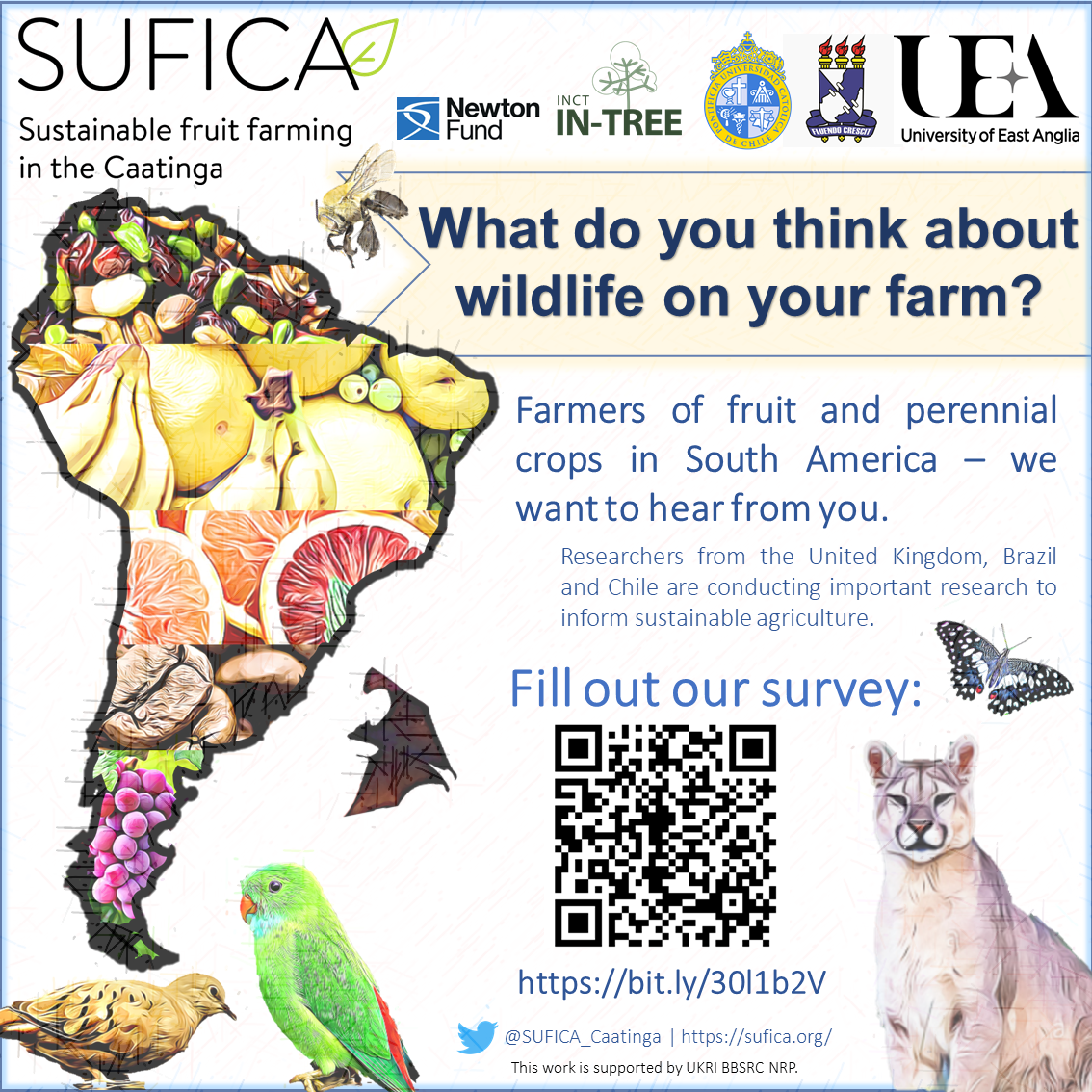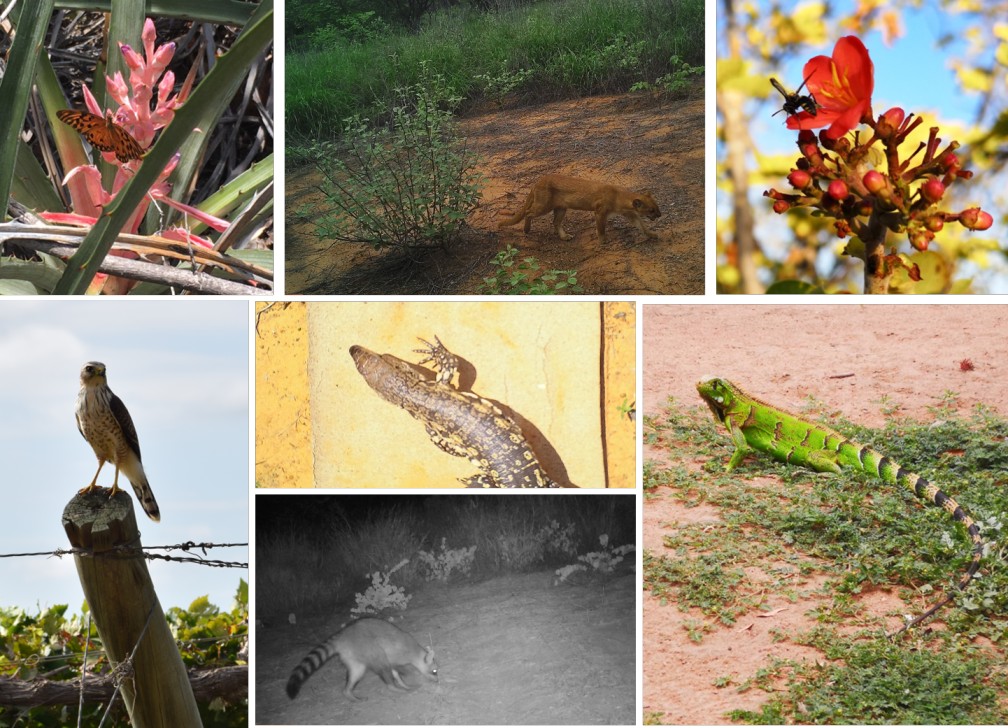Farmers of fruit and perennial crops in South America – we want to hear from you.
What do you think about wildlife on your farm? Scientists from the United Kingdom, Brazil and Chile are conducting research to inform sustainable agriculture in tropical and semiarid regions. They are looking for farmers to fill out their survey to help with the research.
Scientists want to hear from fruit and perennial crop farmers to understand what they think about birds, mammals, insects and nature on their farm. They’d like to find out how farmers control species that damage their crops and what they do to attract species that they like seeing on the farm. The aim of this study is to gain an understanding of perceptions and management of biodiversity across South America to better inform future nature-based management practices that improve production and conserve biodiversity.

Why is this important?
This study comes at a crucial time as agriculture occupies over 40% of world’s land surface (Millennium Ecosystem Assessment 2005; Zabel et al. 2019) and is a threat to many species through habitat loss (Pereira et al. 2012). Biodiversity loss is a global crisis, as we have entered the 6th Mass Extinction (Ceballos et al. 2015), with current extinction rates 1000 times higher than historic rates (Pimm et al. 2014). Sustainable food production is essential to reversing this biodiversity loss (Leclère et al. 2020).
Global agriculture is not expanding uniformly, and some regions of the world such as South America are under the strongest pressure to produce food (Zabel et al. 2019; Tilman et al. 2017). South America is also one of the most diverse regions in the world, home to unique and threatened species. Unfortunately, these regions also suffer from a lack of research into sustainable farming (van der Meer et al. 2020).
Agricultural intensification that helps to meet the world’s food demands can be achieved in sustainable ways that protect natural habitats (Phalan et al. 2019). High-yielding food production systems can operate within thriving agricultural ecosystems, which are rich in biodiversity that supports production. Well-managed agricultural ecosystems can protect farmer livelihoods and biodiversity by becoming resilient to environmental change and by providing less hostile habitats for threatened species. Success of this relies on research that can inform sustainable management.
Sustainable Fruit Farming In The Caatinga (SUFICA) project (https://sufica.org/), aims to enhance the competitiveness, sustainability and long-term resilience of fruit farming in Brazil as it intensifies, through research on agricultural ecosystem services and biodiversity. The project co-designs and tests nature-based innovations on intensive fruit farms, working directly with fruit farmers and industry partners. Now, the project is interested in gathering information from farmers across all South America to inform management recommendations for tropical fruit and perennial crop systems.

How can I be involved? How can I help?
Fruit and perennial crop farmers are invited to participate in this study by filling out a 15-minute online survey. Farmers across South America will benefit from the results of this study as the results will be clearly communicated through the project and local partners.
The survey is available online in English, Portuguese and Spanish. If you have any questions, please feel free to contact Natalia Zielonka (n.zielonka@uea.ac.uk, University of East Anglia), Dr Fabiana Oliveira da Silva (fabianaosilva@academico.ufs.br, Universidade Federal de Sergipe) or Dr Eduardo Arellano (eduardoarellano@uc.cl, Pontificia Universidad Católica de Chile).
The work is supported by the UKRI Biotechnology and Biological Sciences Research Council Norwich Research Park Biosciences Doctoral Training Partnership, the Newton Fund (UK), CONICYT (Chile) and INCT-IN-TREE.

Ceballos, G., Ehrlich, P.R., Barnosky, A.D., García, A., Pringle, R.M. & Palmer, T.M. 2015. Accelerated modern human-induced species losses: Entering the sixth mass extinction. Science Advances 1: e1400253.
Leclère, D., Obersteiner, M., Barrett, M. et al. 2020. Bending the curve of terrestrial biodiversity needs an integrated strategy. Nature 585: 551–556.
Millennium Ecosystem Assessment, 2005. Ecosystems and Human Well-being: Synthesis. Island Press, Washington, DC.
Phalan, B., Green, R.E., Dicks, L.V., Dotta, G., Feniuk, C., Lamb, A., Strassburg, B.B.N., Williams, D.R., Ermgassen, E.K.H.J.z., Balmford, A., 2016. How can higher-yield farming help to spare nature? Science 351, 450-451.
Pereira HM, Navarro LM, Martins IS. 2012. Global Biodiversity Change: The Bad, the Good, and the Unknown. Annual Review of Environment and Resources 37:25-50. Pimm SL, Jenkins CN, Abell R, Brooks TM, Gittleman JL, Joppa LN, Raven PH, Roberts CM, Sexton JO. 2014.
The biodiversity of species and their rates of extinction, distribution, and protection. Science 344:1246752.
Tilman, D., Clark, M., Williams, D.R., Kimmel, K., Polasky, S., Packer, C., 2017. Future threats to biodiversity and pathways to their prevention. Nature 546, 73-81. Van der Meer, M., Kay, S., Lünscher, G. & Jeanneret, P. 2020. What evidence exists on the impact of agricultural practices in fruit orchards on biodvieristy? A systematic map. Environmental Evidence, 9: 2.
Zabel F, Delzeit R, Schneider JM, Seppelt R, Mauser W, Václavík T. 2019. Global impacts of future cropland expansion and intensification on agricultural markets and biodiversity. Nature Communications 10:2844
Natalia Zielonka
14.10.20

